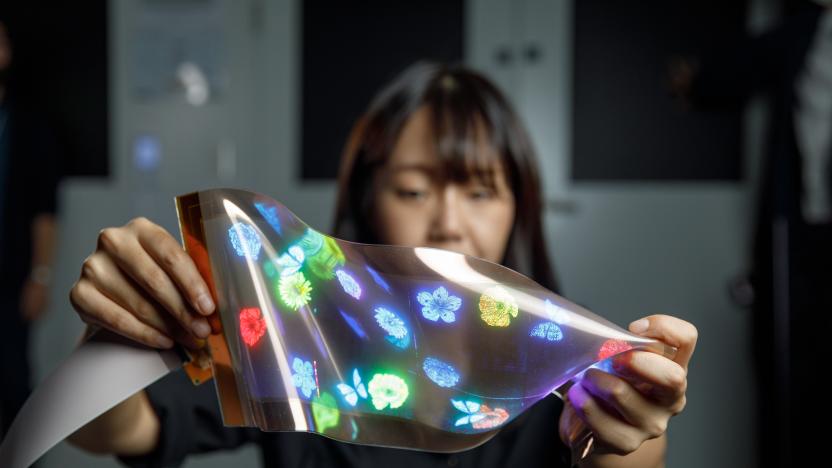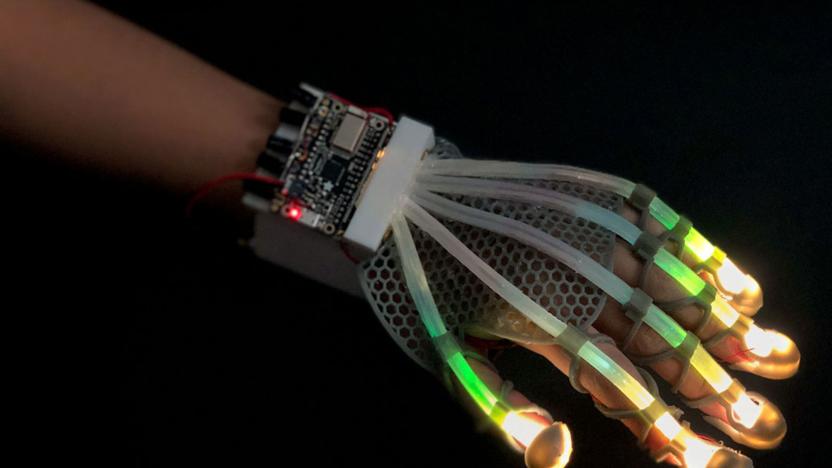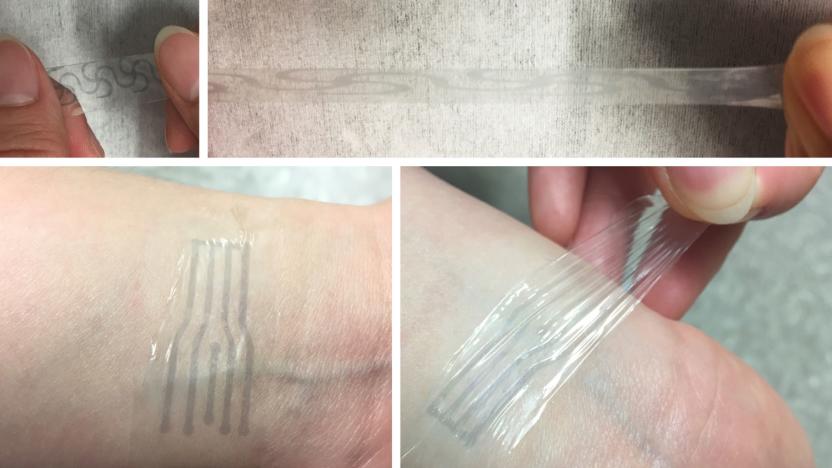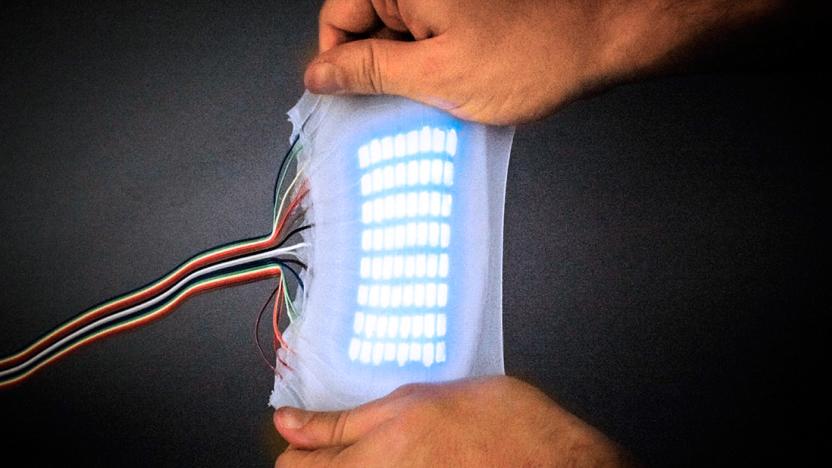stretchable
Latest

LG's latest display can be stretched by 20 percent
LG Disply has developed a 12-inch stretchable display that can be extended in size to 14 inches, the company announced.

Stretchable skin sensor could help you touch things in VR
Cornell researchers have made a stretchable skin sensor whose light-based approach could bring human-like touch to VR and robots.

Samsung's extra-stretchable display can survive dents
Flexible displays are nothing new. However, most of them don't live up to the dreams of flexible tech -- they may only bend in a limited way. Samsung thinks it can do better. It just unveiled a 9.1-inch prototype OLED display that's stretchable in seemingly every way imaginable: you can bend, roll and even dent it (up to half an inch deep) knowing that it'll revert to its original form. The technology is still very young, but Samsung believes the stretchy screen will be useful for everything from wearables to in-car displays. Imagine a very thin smartwatch that can take some knocks without smashing into pieces.

Scientists make stretchy electronics using a soup ingredient
For smart clothing or skin-worn devices to improve, first we need electronics that won't snap like a twig when you move. Using a soup thickener, of all things, scientists from Stanford's Bao Lab created a flexible electrode with "uncompromised electrical performance and high stretchability," said lab director Zhenan Bao. The material could one day be used in better brain-monitoring electronics and smart clothing embedded with heart sensors, LEDs and other tech.

Robots could get soft, stretchable skin that changes colors
Researchers from Cornell University have developed a potential skin material that lights up and stretches to more than six times its original size. The so-called hyper-elastic, light-emitting capacitors (HLECs) are made from transparent hydrogel electrodes wrapped around an insulating dielectric sheet, allowing them to light up when stretched or rolled. Since the skin can handle twice as much strain as earlier materials, it could function as a skin for soft robots that light up to display "emotions."

Stretchy circuits will make for better wearables and robots
Smart clothing and robots alike might soon get better thanks to a breakthrough from a team of Swiss researchers. They created relatively thin electronic circuits that can be stretched like rubber up to four times their original length in any direction. In addition, it can be cycled that way nearly a million times without cracking or losing conductivity. That makes it perfect for biological sensors, artificial skin, prosthetics or for electronics that can easily be sewn into fabrics.

Batteries that stretch are perfect for smart watches and clothes
Used to be that the only time your lithium-ion batteries changed their shape was when they were about to explode in an airliner cargo hold. But thanks to the ingenuity of an Arizona State University research team, future power packs could not only bend but stretch up to 150 percent of their original size while providing an uninterrupted stream of power. Their secret: the ancient Japanese art form of Kirigami. It's an offshoot of the more well-known Origami form that involves both folding and cutting the working material.

Stretchable, serpentine lithium-ion battery works at three times its usual size
While we've seen more than a few flexible batteries in our day, they're not usually that great at withstanding tugs and pulls. A team-up between Northwestern University and the University of Illinois could give lithium-ion batteries that extreme elasticity with few of the drawbacks you'd expect. To make a stretchable battery that still maintains a typical density, researchers built electrode interconnects from serpentine metal wires that have even more wavy wires inside; the wires don't require much space in normal use, but will unfurl in an ordered sequence as they're pulled to their limits. The result is a prototype battery that can expand to three times its normal size, but can still last for eight to nine hours. It could also charge wirelessly, and thus would be wearable under the skin as well as over -- imagine fully powered implants where an external battery is impractical or unsightly. There's no word yet on whether there will be refined versions coming to real-world products, but we hope any developments arrive quickly enough to give stretchable electronics a viable power source.

NC State builds stretchable wires from liquid metal, keeps headphones humming (video)
More than a few of us have had that moment of panic when our headphone cords catch on an object and cut the listening short -- sometimes permanently. Researchers at North Carolina State University could help mitigate those minor musical catastrophes with wiring that stretches up to eight times its normal length. The method fills an elastic polymer tube with a liquid gallium and indium alloy that delivers the electricity. By keeping the materials separate, unlike many past attempts, the solution promises the best of both worlds: the conduction we need, and the tolerance for tugs that we want. NC State already has an eye on stretchable headphone cords, as you'll see in the video after the break, but it also sees advantages for electronic textiles that could endure further abuse. As long as the team can eventually solve a problem with leakage when there's a complete break, we'll be glad enough to leave one of our common audio mishaps in the past.

NCSU creates stretchable conductors from silver nanowires, lets gadgets go the extra inch
As often as we've seen flexible electronics, there haven't been many examples that could stretch -- a definite problem for wearables as well as any gadget that could afford to take a pull or squeeze. North Carolina State University's Yong Zhu and Feng Xu may have covered this gap through a form of silver nanowire conductor that keeps the energy flowing, even if the wire is stretched as much as 50 percent beyond its original length. By coating the nanowires with a polymer that traps the silver when solid, the researchers create an elastic material that can crumple and let the nanowire take the strain without interruption. Although the stretchy conductor's nature as a research project could put any practical use years into the future, Zhu notes that it can take loads of abuse, making it a perfect fit for rugged mobile devices. It should also allow for robots with a gentler touch and a more natural look... although we'll admit we're skittish about the creepy androids likely to follow.

Korean researchers create stretchy transistors made of graphene
Graphene's greatness comes from its flexibility, both figurative -- you can make everything from transparent speakers to stain resistant pants with the stuff -- and literal. And now researchers in Korea have given us another pliable graphene product by creating a stretchy transistor from the carbon allotrope. The trick was accomplished by first layering sheets of graphene on copper foil and bonding it all to a rubber substrate. To complete the transistor channels were etched onto its surface, then electrodes and gate insulators made of ion gel were printed onto the device. What resulted was a transistor that could stretch up to five percent without losing any electrical efficiency, and the plan is to increase its elasticity through continued research. Keep up the good work, fellas, we can't wait for our flexible phone future.

NC State's coiled nanowire discovery could lead to stretchable electronic devices
Cotton may very well be the fabric of our lives, but it'd sure feel a lot better draped across our skin if we could incorporate stretchable electronic devices into it. That's the goal of NC State's own Dr. Yong Zhu, who has worked with a team of gurus to create "the first coils of silicon nanowire on a substrate that can be stretched to more than double their original length." Essentially, this type of breakthrough brings us one (major) step closer to "incorporating stretchable electronic devices into clothing, implantable health-monitoring devices, and a host of other applications." Compared to prior studies on buckling, this particular approach one-ups those focusing on freestanding nanowires, with the new coils' mechanical properties enabling them to be "stretched an additional 104 percent beyond their original length." That's a lot of technobabble, for sure, but what you need to realize is just how amazing your life will be as soon as The Zhu Crew figures out how to improve the reliability of the electrical performance when the coils are stretched to the limit. Flexible PMPs woven into your ski jacket? Bendable LCDs sewn right into your car's headrests? The future... it's here.




